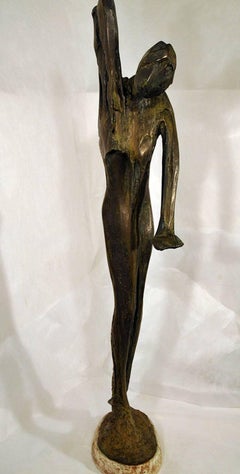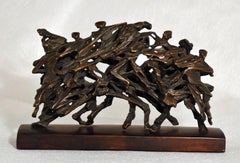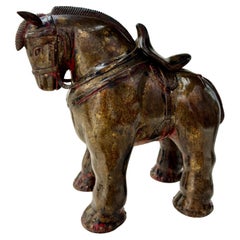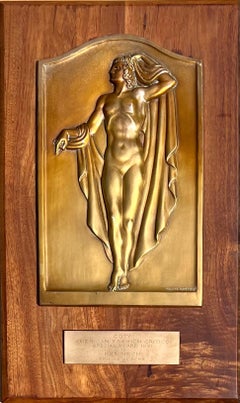Robert Cook Figurative Sculptures
to
1
1
Overall Width
to
Overall Height
to
2
1
2
2
2
2
2
1
1
2
2
1
1
5
125
100
94
88
2
Artist: Robert Cook
Up
By Robert Cook
Located in New York, NY
Bronze, 1967. Height 59" (149.9 cm) width max 15" (38 cm).
Signed on base "R Cook." This unique large sculpture was made using the lost wax process.
“ ...
Category
Mid-20th Century American Modern Robert Cook Figurative Sculptures
Materials
Stone, Bronze
$35,000
Harlem III
By Robert Cook
Located in New York, NY
Signed, titled, and dated in ink on base verso. Unique sculpture created using the lost wax process. This piece is 7 1/2" high x 12" wide x 3 1/2" deep.
Robert Cook was born in Boston in 1921. He studied with George Demetrios...
Category
1990s Modern Robert Cook Figurative Sculptures
Materials
Bronze
Related Items
Botero Style Bronze Horse Sculpture
Located in Lake Worth Beach, FL
Botero Style Bronze Horse Sculpture
Large and decorative bronze horse with removable saddle Botero style inspired, quality patinated bronze with some red and black trace of paint.
Category
2010s Modern Robert Cook Figurative Sculptures
Materials
Bronze
1961 Coty Award Plaque Kenneth Hairdresser Jacqueline Onassis Bronze Fashion
Located in New York, NY
1961 Coty Award Plaque Kenneth Hairdresser Jacqueline Onassis Bronze Fashion
Bronze on wood. The wood plaque measures 12 3/4" by 20 3/4 inches. The bronze plaque itself is 13 3/4 x 8 3/4 inches and the the bronze inscription, which reads "COTY, American Fashion Critics Special Award 1961 to KENNETH of LILY DACHE...
Category
1960s American Modern Robert Cook Figurative Sculptures
Materials
Bronze
$6,800 Sale Price
20% Off
H 21 in W 13 in
Arabesque, Female Ballet Dancer in Motion, Bronze Gray Bas Relief Sculpture Art
By Eric Bransby
Located in Denver, CO
This stunning figurative bas relief sculpture captures a female ballet dancer gracefully poised in the arabesque position, created by the acclaimed Colorado/Missouri artist Eric Bransby (1916-2020). Crafted from bronze and polymer Forton casting, the piece beautifully exemplifies Bransby’s mastery of motion and form.
Provenance:
Collection of the artist, Eric Bransby
About Eric Bransby:
Eric James Bransby was a highly respected muralist, painter, illustrator, and educator. His education at the Colorado Springs Fine Art Center included studies with renowned artists like Thomas Hart Benton, Jean Charlot, Boardman Robinson, and Josef Albers. He also studied at the prestigious Yale School of Fine Art.
Bransby’s career is defined by his exceptional work as a muralist, with notable commissions including the Rockhurst Library Triptych Mural at the University of Missouri, murals at Brigham Young University, the U.S. Air Force Academy...
Category
20th Century American Modern Robert Cook Figurative Sculptures
Materials
Bronze
$6,400 Sale Price
20% Off
H 40 in W 30 in D 3 in
Chaim Gross Mid Century Mod Bronze Sculpture Mother and Baby Playing WPA Artist
By Chaim Gross
Located in Surfside, FL
Chaim Gross (American, 1904-1991)
Cast bronze sculpture
Caring (or Mother and Child)
signed
Mounted on wooden plinth
Featuring a mother raising her child up in superb high relied i...
Category
Mid-20th Century American Modern Robert Cook Figurative Sculptures
Materials
Bronze
$2,400
H 9 in W 7.5 in D 3.5 in
Harmony, 20th century bronze & green marble base, nude man and woman with lyre
By Max Kalish
Located in Beachwood, OH
Max Kalish (American, 1891-1945)
Harmony, c. 1930
Bronze with green marble base
Incised signature on right upper side of base
14 x 9 x 5 inches, excluding base
17 x 10 x 8 inches, including base
Born in Poland March 1, 1891, figurative sculptor Max Kalish came to the United States in 1894, his family settling in Ohio. A talented youth, Kalish enrolled at the Cleveland Institute of Art as a fifteen-year-old, receiving a first-place award for modeling the figure during studies with Herman Matzen. Kalish went to New York City following graduation, studying with Isidore Konti...
Category
1930s American Modern Robert Cook Figurative Sculptures
Materials
Marble, Bronze
$10,450
H 17 in W 10 in D 8 in
Large Gilt Bronze Sculptures of Cheetahs
Located in Rome, IT
Fantastic pair of gilt bronze Cheetahs sculptures . The item will be well-suited to either an indoor or outdoor setting.
Category
Early 2000s Modern Robert Cook Figurative Sculptures
Materials
Bronze
Large Gilt Bronze Sculptures of Cheetahs
Located in Rome, IT
Fantastic pair of gilt bronze Cheetahs sculptures . The item will be well-suited to either an indoor or outdoor setting.
Category
Early 2000s Modern Robert Cook Figurative Sculptures
Materials
Bronze
Mother Playing, Bronze and Wood Sculpture by Chaim Gross
By Chaim Gross
Located in Long Island City, NY
An abstract modern cubist rendition of a mother playing with her child by Chaim Gross (Austrian, 1904 - 1991). Chaim Gross is known for these playful works and similar works can be f...
Category
1970s Modern Robert Cook Figurative Sculptures
Materials
Bronze
Renegade
By Brad Rude
Located in Bozeman, MT
Ed. 3/6
Artist Brad Rude was born in Montana and has lived in Walla Walla, Washington most of his life. His journeys through his grandfather's folk art st...
Category
2010s American Modern Robert Cook Figurative Sculptures
Materials
Bronze, Enamel
"Zofar" Boaz Vaadia, Human Body, Bronze and Stone, Anthropomorphic Sculpture
By Boaz Vaadia
Located in New York, NY
Boaz Vaadia
Zofar, 1997
Bronze, bluestone, and boulder
Overall 20 x 29 x 27 inches
From the edition of 7
Provenance
Elaine Baker Gallery, Boca Raton, Florida
Boaz Vaadia is the in...
Category
1990s American Modern Robert Cook Figurative Sculptures
Materials
Bluestone, Stone, Bronze
$40,000
H 20 in W 29 in D 27 in
Construction & Garment Worker, WPA Bronze by Robert Cronbach
By Robert Cronbach
Located in Long Island City, NY
Artist: Robert Cronbach, American (1908 - 2001)
Title: Construction & Garment Worker
Year: 1938
Medium: Bronze sculpture with Brown Patina, signature and date in the cast
Size: 18 ...
Category
1930s American Modern Robert Cook Figurative Sculptures
Materials
Bronze
$28,000
H 19 in W 11 in D 9 in
Le Roitelet
By François-Xavier Lalanne
Located in PARIS, FR
EDITION
Monogrammed : FXL
Dated : 2003
Numbered EA 2/4B
Stamped with foundry mark : bocquel fd.
PROVENANCE
Marie Lalanne former collection, daughter of the artist.
LITERATURE
W....
Category
Late 20th Century Modern Robert Cook Figurative Sculptures
Materials
Bronze
Previously Available Items
Virasat Curved, figurative bronze mantle piece
By Robert Cook
Located in New York, NY
A remarkable and unique format bronze of unique cast that could be great for a mantle or console table.
In Robert Cook's book entitled “Waxing and Waning” he discusses three castings...
Category
Early 2000s American Modern Robert Cook Figurative Sculptures
Materials
Stone, Bronze
Bronze Sculpture of a Skier
By Robert Cook
Located in Wiscasett, ME
Bronze sculpture of a skier signed on the bottom "R. Cook", great movement in this piece.
Robert Cook is an innovator in the “lost wax” process of casting, creating larger sculptures than had previously been possible. He has a number of major public sculptures in New York...
Category
1960s Modern Robert Cook Figurative Sculptures
Materials
Bronze
Icarus
By Robert Cook
Located in New York, NY
Bronze on wood base. 9" high x 7" wide x 3" depth. Signed in bronze. Unique sculpture created using the lost wax process. Artist Robert Cook was born in Boston in 1921. He studied with George Demetrios...
Category
1990s Modern Robert Cook Figurative Sculptures
Materials
Bronze
Robert Cook figurative sculptures for sale on 1stDibs.
Find a wide variety of authentic Robert Cook figurative sculptures available for sale on 1stDibs. You can also browse by medium to find art by Robert Cook in bronze, metal, stone and more. Much of the original work by this artist or collective was created during the 20th century and is mostly associated with the modern style. Not every interior allows for large Robert Cook figurative sculptures, so small editions measuring 12 inches across are available. Customers who are interested in this artist might also find the work of Seena Donneson, Tom Binger, and Walter Bastianetto. Robert Cook figurative sculptures prices can differ depending upon medium, time period and other attributes. On 1stDibs, the price for these items starts at $7,200 and tops out at $35,000, while the average work can sell for $11,000.




